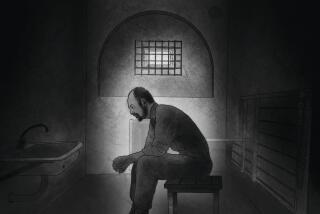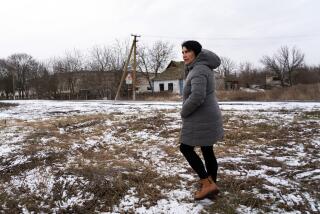Russia’s Northern Flights
VORKUTA, Russia — The gulag is gone, but its prisoners remain.
Poverty and a lifetime of missed chances have marooned Said Asan Dzhamilov in luckless Vorkuta. More than six decades ago, he was among a million inmates sent here to hack coal from the Arctic permafrost and build a city where none would naturally grow.
Today, the 85-year-old still dreams of going home to his native Crimea. But he knows he never will.
“I would leave today if I could. I’m sick and tired of living in Vorkuta. I can’t stand it anymore,” Dzhamilov said. “I’ve lived almost all my life -- for 64 years -- in the north.”
Many who live here want to move south -- and in Russia’s new world of profit and loss, the government wishes they would. Moscow wants to save money by shrinking Vorkuta and dozens of other cities and industrial towns across Russia’s extreme north, built with so much blood, so many tears, such arduous toil in dark underground tunnels and poisonously polluted factories.
Yet undoing what the command economy created brings its own pain.
This city -- made up of former prisoners, miners who came here voluntarily starting in the 1950s, and descendants of both groups -- has shrunk to 137,000 people from about 200,000 a decade ago. Several thousand families have received relocation assistance, and 104,000 people are awaiting moving help, Mayor Igor Shpektor said.
Shpektor complained that at Moscow’s current funding pace, it would take 100 years to assist them all.
Obtaining coal from ever-deeper underground tunnels, sometimes using antiquated equipment, in a place about 1,200 miles northeast of Moscow is a highly inefficient way to supply Russia’s energy needs -- particularly in the face of increased oil and gas production.
Burdened by the high costs of production and transportation, many of Vorkuta’s mines can’t compete, said the mayor, a gruff yet friendly man who exudes affection for this city 60 miles north of the Arctic Circle where the sun never rises in the depths of winter.
Vorkuta used to have 13 coal mines. Today it has six, soon to be five. “The northern areas can’t provide enough jobs, but we can’t just dump the people,” Shpektor said. “So first and foremost people need to be relocated.”
Andrei Markov, a Moscow-based World Bank official overseeing a separate relocation program that has helped about 500 Vorkuta families, said the hope is that with a smaller population, those who stay in the north can live better and work more efficiently.
“The way that industry and economic activity is organized in those northern territories is unacceptably expensive by all international standards,” he said, “so the whole Russian north is in the process of downsizing and upgrading.”
Those still here, by choice or necessity, must adjust to the idea that they are no longer part of a socialist vanguard. A weather-worn Soviet-era slogan mounted on a city building declares, “Glory to the Explorers of the Arctic Region,” but the idea is even more beat-up than the sign.
Nothing seems glorious about downsizing.
“My father died in an accident in 1979,” said Andrei Bylina, 39, a miner’s son who runs a stationery store on Vorkuta’s main street. “That mine is shut down now.... There’s a worm that eats through your heart. I keep asking myself, ‘What did my father die for, if this mine is no longer working?’ ”
A minority of Vorkuta’s residents -- usually those born here -- deeply love their city, with its climatic extremes, its combination of urban amenities and small-town atmosphere, its indoor swimming pools and new artificial-turf soccer field.
Emma Savina, director of the local government office that coordinates the World Bank resettlement program, is one of them.
“I like the lifestyle in Vorkuta,” she said. “I like the blizzards. I like the freezing temperatures that can go down to minus-60. I like the white nights that never get dark. I like it that it’s winter, winter, winter, and then suddenly summer. The tundra turns green in three days. It’s like a slow-motion movie played fast.”
Annual reindeer-sled races down the main street are another thrill, she said.
Shpektor, the mayor, also likes to put a positive spin on Vorkuta’s attractions, recalling with pride how a few years ago he urged the city’s youth to have more babies: “In 1998, I called out to the young people and I said, ‘Young people, why do you need this polar night that lasts almost 24 hours a day if you don’t make love to each other? So take advantage of the dark period of time!’
“And in 1999, the birthrate for the first time exceeded the death rate, and our birthrate has been on the rise ever since.”
Yet the mayor is among those who readily acknowledge that the Soviet method of developing the north was cruel, relying at first on often-innocent prisoners, victims of dictator Josef Stalin’s terror. “The railroad was built by convicts, and they say there’s the body of one convict under each tie,” he said, repeating a widely cited image.
“We actually live in a city built by people who sacrificed their lives for its construction,” said Pavel Yunitsky, 18, a university student born here. “We basically have a situation where we walk on the bones of those people.... I think the ordinary criminals, the murderers, deserved this. At the same time, I feel extremely sorry for the innocent people who were forced to give up their lives to build the city.”
Shpektor said the city must look forward without allowing the past to be a burden. “Today we venerate the honor and memory of those who died here,” he said. “But Vorkuta is a city, it’s not a cemetery. So there shouldn’t be a somber graveyard type of mood.”
Nikolai Khukhovets, 51, who came as a teenager when his father was recruited to work in the mines, said he didn’t think it was so bad that Stalin sent prisoners here. “Nobody would have come here voluntarily, but the state needed coal,” he said. “Maybe some things were done wrong, but the general policy was right.”
Today, however, he is bitter. “They simply closed the mines, so there are no jobs,” he said. “But you can’t leave because you don’t have any money. So you’re stuck here forever.”
The city’s economics never made sense.
The process of extracting minerals from the north was extremely wasteful because year-round communities were established in places where temporary shift labor would have been more efficient, Markov said.
The World Bank effort he oversees -- a pilot project targeting Vorkuta and two other northern areas -- has no waiting list, but it imposes tighter eligibility requirements and provides less money per family than the main government program.
Many residents have fled on their own. In the last 15 years, with the collapse of the Soviet Union and the shift from a socialist planned economy to capitalism, about 1.1 million people have moved away from Russia’s extreme north, leaving behind a population of about 8.8 million, according to official Russian statistics cited by the World Bank.
Yet for these regions and similarly cold or isolated parts of the country to be run efficiently according to free-market principles -- in other words, for the Arctic areas of European Russia and Siberia to reflect the kind of pattern that developed naturally in Canada -- millions more must leave for more temperate parts of the country, Markov said.
Many things are more difficult and expensive in the north because of the high cost of bringing goods here and the harsh climate. Because of this, economists say it would be best to exploit the natural resources of remote and cold regions with the fewest possible permanent residents.
Vorkuta’s history goes back to a 1921 mineral-exploration mission that discovered coal deposits sticking out of the ground, prompting great excitement in the young Soviet government, said Yevgeniya Khaydarova, a leader of the local branch of the human rights group Memorial. Annual expeditions followed.
The first coal mine opened in 1931, using the labor of 3,500 prisoners who initially lived in dug-out shelters and tents, she said. Eventually, the prisoners lived in barracks ringed by barbed wire and watchtowers.
In the 1950s, the coal industry was increasingly turned over to ordinary workers enticed by high salaries and generous social benefits, and the use of prisoners in the mines ended in 1962, Khaydarova said. A central city district and some satellite settlements near the mines were built for the new laborers.
By that time, more than 1 million prisoners had passed through the Vorkuta branch of the Soviet gulag, about 30% of them ordinary criminal offenders and 70% imprisoned on political, ethnic or religious grounds, Khaydarova said. She estimated that about 10,000 were executed or shot in alleged escape attempts and about 90,000 died of hunger, cold or disease while imprisoned.
“By the regulations, a step to the left or a step to the right was a flight attempt, so people were getting killed on the spot,” she said. Guards had an incentive to shoot because if they killed an attempted escapee, they were rewarded with extra vacation days, she said.
For Dzhamilov, the former prisoner, the road to Vorkuta began when he was drafted into a unit of the NKVD, a forerunner of the KGB, in 1939. He served at first as a security guard at facilities in Siberia. But after Adolf Hitler set his Nazi army against the Soviet Union in 1941, Dzhamilov was sent to fight on the Crimean front.
He was soon in a battle in which many in his platoon, including his commander, were killed. Hours later, Dzhamilov and other survivors made it back to the local camp of Soviet troops, only to be falsely accused of having been captured by the Germans and recruited as spies.
“An officer pulled a gun out, pointed it at me and said, ‘Confess that you were taken prisoner and that the Germans recruited you as a spy and released you!’ ” Dzhamilov recalled. “I said no. He said, ‘Confess to it, and you will go back to the front.’ I confessed to it, but they sentenced me to capital punishment instead.”
After months in prison awaiting his execution, that sentence was dropped without explanation, and in 1942 he was sent to Vorkuta to work as a stoker in a heating plant.
He was freed in 1946 but thought, like many other former inmates, that he had to stay in the city. So he found a job, got married, built a home and started a family.
In 1967 he wrote to authorities in Moscow, seeking rehabilitation and permission to travel. The answer came back, he said, that he had been officially rehabilitated in 1946 and had been free to leave Vorkuta ever since.
“I hadn’t known about it for 20 years. The documents went missing,” he said, the pain of what-might-have-been hanging on his words.
The time when it would have been easy to go home had long passed. In later years, he and his wife talked about leaving, but they never did.
Now he sees himself as more unlucky than victimized, refusing to blame Stalin or the communist system for his fate. “I didn’t deserve it, but it happened to me,” he said. “What can we do about it? This was the way the ball bounced back then. This was the natural course of life. So how can you complain about life?”
More to Read
Sign up for Essential California
The most important California stories and recommendations in your inbox every morning.
You may occasionally receive promotional content from the Los Angeles Times.










